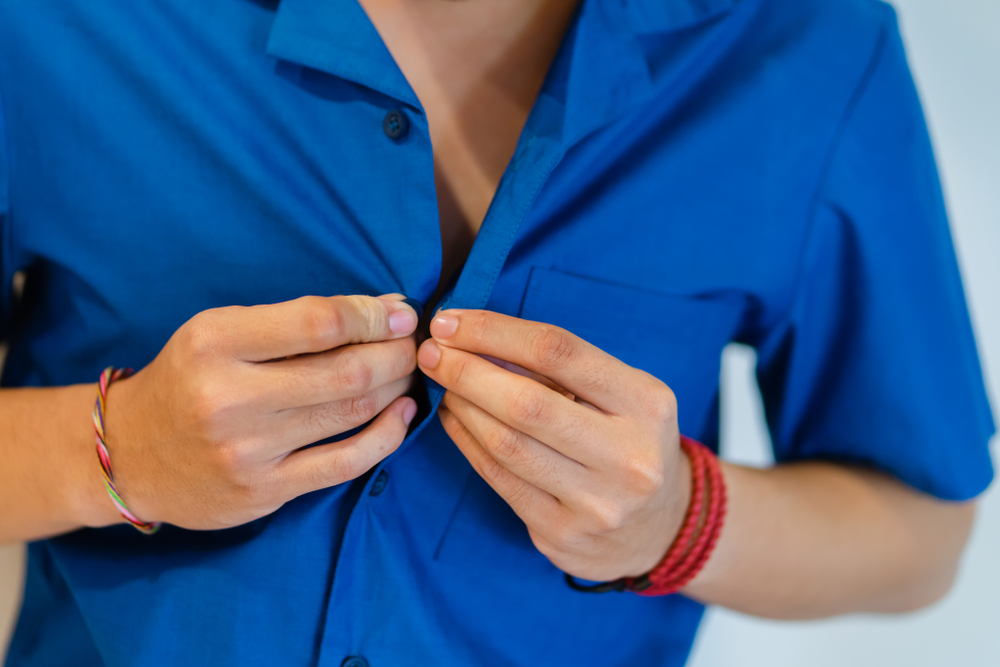Women’s shirts have buttons on the left, while men’s have them on the right. But it’s not about which hand you write with…
The button differential
Once upon a time, your gender determined your fashion choices. For most of the last few hundred years in the Western world, women wore dresses and skirts, and men wore pants. Except for the Scots. Thankfully, fashion has evolved such that both men and women are now free to wear anything they please, although it’s still suggested to take fashion tips from personal stylists.
There are a few gendered fashion trends that persist, however, and it’s one that makes women’s dressing just a little more difficult than it needs to be: buttons! Buttons appear on different sides of a shirt or jacket depending on which gender it was designed for. Despite the fact that the vast majority of all humans are right-handed, only men’s shirts have buttons on the right side. Women’s shirts have buttons on the left side. Great for lefties, but an extra couple of minutes in the morning for everyone else.
It seems particularly absurd given the relative similarity in the shape of men’s and women’s shirts. Sure, there might be a little extra tailoring to account for some generalized curves, but the humble button-up shirt is one of the more unisex items of clothing regularly worn by both sexes. A good shirt can even help you dress to look younger. So why the button bewilderment?
Why women’s and men’s shirts have buttons on different sides
The origins of the opposite-button debate have been lost over time, though historians do have theories. Back in the day (think 13th century), buttons were only for those who could afford them. Everyone else simply tied their clothes with strips of cloth, or fastened them with wooden toggles. As well as having clothes that buttoned, middle- and upper-class women also usually had maids to help them get into and out of their elaborate outfits. It’s difficult to get into corsets, bustles, hoop skirts, and several layers of petticoats by yourself. Knowing that someone else would be doing the buttoning, dressmakers sewed the buttons onto the left side of women’s garments to make it easier for the maid to do them up right-handed. Once clothes started being mass-produced, the custom became standardized, and no one has thought to change it to this day, including during our recent need for stylish tops for Zoom calls.
There are other theories, most notably regarding babies and horses. Again, as most women are right-handed, they tend to carry their wee ones with their left arms on their left hips. This frees up their right hand for answering the phone, putting the kettle on, and unbuttoning their shirt if still breastfeeding. With regard to horses, well, women started off riding sidesaddle, usually turned to the left side. Although this is almost certainly terrible news for your back and hips, shirts and jackets that buttoned with the right flap over the left would let in less wind as you galloped along.
Right-hand dominance
But what about men? True, having considerably less constrictive outfits, they usually dressed themselves. That may have contributed to the right-button-placket convention. But the real answer might go way, way back to the days of knights, jousting, and chivalry. Men’s shirts button with the left flap over the right, which mimics one of the oldest conventions of battle: Shield on the left arm, sword in the right. As your enemy’s lance would have been in his right hand, armor plates overlapped from left to right to keep that shield side doubly protected. Even as times changed and weaponry evolved, men’s clothing retained echoes of military trappings, and was often designed to include accommodations for swords and pistols. As these were mostly held in the right hand, it was advantageous to be able to unbutton with the left.
So there you have it! The thing is, there’s absolutely no reason why this strange artifact of gender inequality should linger on in today’s buttoned garments. Lefties may disagree, but living in a world that respects right-hand dominance when it comes to coats, jackets, and shirts would be another (if admittedly small) step toward gender equality. After all, the button differential has been used before to argue that women are physically inferior to men, needing help to dress themselves as they must. Why else would the buttons be on the left side? But, short of switching to zippers, we might be stuck with button bewilderment for a few more years. Of course, there’s always the option to tailor your own clothes instead.








